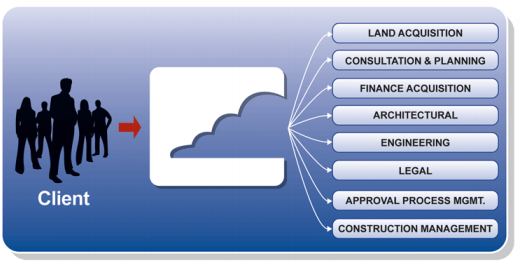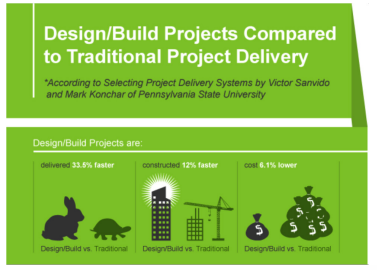Will The Design-Build Method Take Over (PDF)
By Mike Regina, Principal – Big Sky Enterprises, LLC
Let’s explore the design-build method. The desire for one-stop shopping is everywhere. We have become a nation of streamliners and practical thinkers.

Smart players in every industry have been silently rethinking and repositioning themselves for success in today’s economy. What does that look like? Businesses are hand-picking leaders and putting together powerful multi-discipline teams that can handle all parts of a project within one entity. The concept of an interdisciplinary approach is really nothing new. It has been modeled again and again in every business sector.
Is this a monopoly? Or is it business excellence?
The only way to truly answer this question is by asking the most important one: Does it put the customer, or end user, at an advantage or disadvantage? That’s the only real way to gauge a business ideal.
THE CUSTOMER’S NEEDS
When customers are looking for a design-build contract, they are ultimately saying:
• I want one point of contact
• I don’t want to be faced with questions I don’t have answers to
• I don’t want to have to do homework, legwork, or anything else
They’re saying, “Here’s my need. Here’s my budget. Make it happen.” Besides a customer’s ultimate desire to see a project go from concept to fulfillment without financial surprises, delays or disappointment, there are other reasons the design-build model has experienced unprecedented growth over the past decade:
Benefits of the design-build process
 One thing I’ve learned over the years is that regardless of the economy or shifts in trends, there will always be a market for excellence. The design build concepts, like the design build process at Big Sky evolved from our ongoing commitment to learn, grow, and improve. In almost every situation, design-build is superior to traditional construction.
One thing I’ve learned over the years is that regardless of the economy or shifts in trends, there will always be a market for excellence. The design build concepts, like the design build process at Big Sky evolved from our ongoing commitment to learn, grow, and improve. In almost every situation, design-build is superior to traditional construction.
The difference between the two is pretty straightforward. With the design build model, both the design and construction of a project are under the umbrella of one single entity. This is completely different
from the traditional, almost lethargic, designbid-build process where the owner chooses the engineer or architect to design the project, and competitive bids are taken from other entities for the performance of construction services. It even sounds like snail-pace.
Design-build keeps the control, and the liability off of the owner, exactly where it belongs. The owner typically provides general design specifications and desired performance specifications, but the
detailed construction plans and specs are the responsibility of the design-build team, instead of the owner’s engineer or architect. Accordingly, the implied warranty of specifications will not follow the trail from the owner to the contractor. Instead, the contractor bears the risk of non-performance.
Other clear benefits of the design-build process include:
Quality – When quality responsibility is on the builder, there is clear motivation to produce superior results. This contrasts with the traditional design-bid-build method, where responsibility falls to the owner.
Financial Savings – When design and construction work hand-in-hand, multiple options can be explored and efficient solutions brought to the table before the production of drawings.
Streamlining for Time Efficiency– Design and construction can overlap and collaboration during the initial design phase can eliminate redesign time. Instead of a bottleneck, construction can actually begin before the working drawings are complete.
Early Cost Guarantee – Without all the “what if” scenarios it’s much easier to procure financing commitments at significantly reduced out-of-pocket costs prior to the availability of loan proceeds.
The Solution to the “Never Ending Change Orders” – With project scope and price out of the way, change orders stemming from design coordination issues are eliminated, along with the headache and lost time. Correction of such issues is the responsibility of the design-builder, not the owner.
Risk Incentive – Incentives are always nice. With the design-build model the incentive to improve efficiency without sacrificing quality translates into innovative ideas, problem solving, proactive thinking, and design and construction teams working together, evaluating alternatives efficiently and accurately, while bringing value to the owner.
Mike Regina – Principal / Co-founder
Co-founder of Big Sky Enterprises, Mike Regina brings over 20 years of industry experience and expertise to the firm. Michael strategizes, oversees and performs multiple mission critical initiatives for Big Sky. His areas of direct responsibility include project feasibility analysis, project management and business development.
For more information contact:
 Mike Regina | Principal
Mike Regina | Principal
Big Sky Enterprises
Phone: 856.435.8400 | Fax: 856.435.8410
2 Eastwick Dr, Suite 101, Gibbsboro, NJ 08026
www.bigskyllc.com


